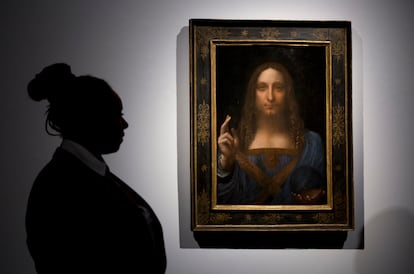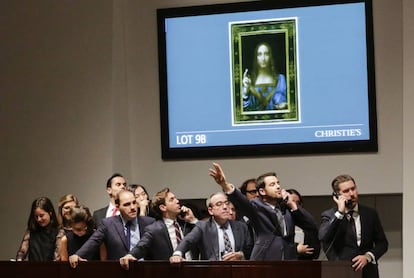Two decades under the mystery of the 'Salvator Mundi'

Like a prisoner serving a sentence, the most expensive painting in history, Salvator Mundi , attributed to Leonardo da Vinci (1492-1519), has been celebrating 20 years and one month since its discovery. It has not been seen publicly since its auction sale for $450 million (about €380 million) in 2017. Doubts about its attribution arise. So too does speculation about where it might be. In December 2018, The New York Times revealed that the buyer was Saudi Prince Mohammed bin Salman . That year, it arrived at the Louvre in Paris for study, but the catalogue was never published. A journalist from the New York Times obtained the only copy. The idea was to display it in the French art gallery, perhaps alongside the Mona Lisa . Something the French government reportedly refused. The Salvator never reappeared. “I have seen the catalogue prepared for the painting's inclusion in the Louvre exhibition, and it fully supports the attribution to Leonardo and provides additional scientific and technical information,” reveals Robert Simon, a well-known dealer and historian of the Italian Renaissance, along with his partner, Alexander Parish, who discovered the work.
But questions spill forth like water in a waterfall. Could there have been a political disagreement over the desire to display it next to the Mona Lisa ? Is the portrait part of the country's cultural strategy known as Saudi Vision 2030? Will it be the star of a new museum in Riyadh, as Princeton University scholar Bernard Haykel has suggested, placing it in a Geneva security vault? Is it also a way to whitewash the 2018 murder of journalist Jamal Khashoggi ? Will it be the star of the new Louvre in Abu Dhabi and will it appear there first? After all, it opened its doors when the painting was auctioned. The unorthodox writer Kenny Scharter places it on the 123-meter yacht Serene , owned by Prince Mohammed bin Salman. The truth is, anyone can build a museum around it. Perhaps spending $450 million wasn't the greatest eccentricity of a prince who, 20 years ago, rolled the dice on a Christ whose image, left unrestored, seemed like a Calvary.
We are left with history. On April 10, 2005, a walnut panel on oil, with the back supported by wooden slats, in very poor condition, fractured, and with a 19th-century frame, was auctioned under lot number 664, on page 110, at a little-known auction house in New Orleans (St. Charles Gallery), under the attribution After Leonardo da Vinci. (Italian, 1452–1519) Christ Salvador [sic] Mundi . (After Leonardo da Vinci. Christ the Savior of the World (Italy, 1452-1519). Its starting price was between $1,200 and $1,400, but it sold for just over $10,000. But in a few years it would become the most expensive painting (66 x 47 cm) in history. It was auctioned at Christie's New York in 2017 for $450 million (about €400 million). The Salvator Mundi became for some experts the last Leonardo da Vinci . A myth also created by marketing. The certainty is that there are only 16 or 17 works undoubtedly attributed to the genius of the Renaissance. In addition, there are about 27 versions of the Salvator Mundi . But none of his disciples - not even Boltraffio (1467-1516), who was undoubtedly the best - had the talent to draw the blessing hand or the curls on the left side of the head, which are identical to the Saint John the Baptist (1513-1516) in the Louvre. The repainted face, on the other hand, was almost burlesque.

But one had to have faith that behind that painting, which threatened ruin, Leonardo had worked centuries ago with his tireless genius. Robert Simon and his partner, Alexander Parish, won the auction; and they defend it. “The face was probably repainted, but the blessing hand was of very high quality,” Simon recalls. He adds: “Yes, it was risky to buy the panel, but in life you have to take risks, and this time it worked out well.” On the back, the initials CC could be read, referring to the Cook Collection. The Salvator Mundi had once belonged to it. On June 25, 1958, it was sold at Sotheby's, along with 136 other works, for around 120 euros, under the attribution to Boltraffio.
From here the novel begins. Graham Green could have titled it The Leonardo Factor . The Florentine polymath ticks it all: a genius, an iconic figure, a museum's sense of purpose, endless queues, and a lot of money. The National Gallery showed it in its best-selling exhibition—despite the fact that not many works for sale are usually shown in a public museum—dedicated to the master in 2011. Shortly after, in 2012, Simon and Parish tried to sell the work to the Dallas Museum, but the institution was unable to raise the requested funds. Complicating matters, several trustees were unconvinced by the Leonardo authorship. After two years of restoration by Dianne Modestini ("some might argue that the panel should have been left unrestored, like an archaeological relic; I disagree: it is now alive and moving," argues Robert Simon) and an equal amount of research (some 27 variations of the painting from his studio were reviewed), Simon believed this was the authentic one. "It was a moment of shocking understanding and astonishment," he emphasizes. It also revealed the darkest side of art. The one that leads to free ports (places where works are stored and are technically considered in transit, therefore exempt from taxes), money laundering, and deception.

With the help of American dealer Warren Adelson, an expert primarily on the work of John Singer Sargent (1856-1925), the painting was sold privately in April 2013, according to The New Yorker , through Sotheby's, to Russian oligarch Dmitry Rybolovlev, who had acquired it in a lot with other 20th-century works offered by Swiss intermediary Yves Bouvier, owner of numerous freeports. Rybolovlev believed that Bouvier was acting as his agent, taking a 2% cut. The reality was different: the Swiss dealer acquired the pieces directly from the owners and, according to the American newspaper, resold them to his client for a much higher sum. In just a few years, he earned nearly $1 billion.
Salvator Mundi was no exception. Bouvier bought it for 80 million and sold it the next day to the oligarch for 127.5 million dollars. The Russian “collector” decided to part with all his works and sue Bouvier for fraud in several jurisdictions. What followed was an excellent marketing strategy. Loic Gouzer, head of contemporary art at Christie's, included it in November, under a huge advertising campaign ( The Last Leonardo ), in his current art section, and after 19 minutes of bidding, in In 2017, it sold for $450 million. Then it disappeared.
EL PAÍS




